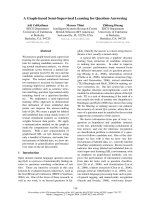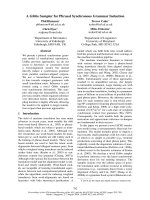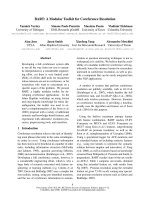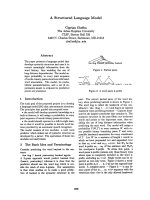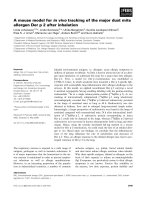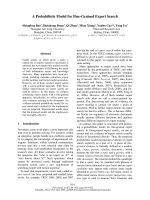Báo cáo khoa học: "A Structured Model for Joint Learning of Argument Roles and Predicate Senses" pot
Bạn đang xem bản rút gọn của tài liệu. Xem và tải ngay bản đầy đủ của tài liệu tại đây (997.56 KB, 5 trang )
Proceedings of the ACL 2010 Conference Short Papers, pages 98–102,
Uppsala, Sweden, 11-16 July 2010.
c
2010 Association for Computational Linguistics
A Structured Model for Joint Learning of
Argument Roles and Predicate Senses
Yotaro Watanabe
Graduate School of Information Sciences
Tohoku University
6-6-05, Aramaki Aza Aoba, Aoba-ku,
Sendai 980-8579, Japan
Masayuki Asahara Yuji Matsumoto
Graduate School of Information Science
Nara Institute of Science and Technology
8916-5 Takayama, Ikoma,
Nara, 630-0192, Japan
{masayu-a, matsu}@is.naist.jp
Abstract
In predicate-argument structure analysis,
it is important to capture non-local de-
pendencies among arguments and inter-
dependencies between the sense of a pred-
icate and the semantic roles of its argu-
ments. However, no existing approach ex-
plicitly handles both non-local dependen-
cies and semantic dependencies between
predicates and arguments. In this pa-
per we propose a structured model that
overcomes the limitation of existing ap-
proaches; the model captures both types of
dependencies simultaneously by introduc-
ing four types of factors including a global
factor type capturing non-local dependen-
cies among arguments and a pairwise fac-
tor type capturing local dependencies be-
tween a predicate and an argument. In
experiments the proposed model achieved
competitive results compared to the state-
of-the-art systems without applying any
feature selection procedure.
1 Introduction
Predicate-argument structure analysis is a process
of assigning who does what to whom, where,
when, etc. for each predicate. Arguments of a
predicate are assigned particular semantic roles,
such as Agent, Theme, Patient, etc. Lately,
predicate-argument structure analysis has been re-
garded as a task of assigning semantic roles of
arguments as well as word senses of a predicate
(Surdeanu et al., 2008; Haji
ˇ
c et al., 2009).
Several researchers have paid much attention to
predicate-argument structure analysis, and the fol-
lowing two important factors have been shown.
Toutanova et al. (2008), Johansson and Nugues
(2008), and Bj
¨
orkelund et al. (2009) presented
importance of capturing non-local dependencies
of core arguments in predicate-argument structure
analysis. They used argument sequences tied with
a predicate sense (e.g. AGENT-buy.01/Active-
PATIENT) as a feature for the re-ranker of the
system where predicate sense and argument role
candidates are generated by their pipelined archi-
tecture. They reported that incorporating this type
of features provides substantial gain of the system
performance.
The other factor is inter-dependencies between
a predicate sense and argument roles, which re-
late to selectional preference, and motivated us
to jointly identify a predicate sense and its argu-
ment roles. This type of dependencies has been
explored by Riedel and Meza-Ruiz (2008; 2009b;
2009a), all of which use Markov Logic Networks
(MLN). The work uses the global formulae that
have atoms in terms of both a predicate sense and
each of its argument roles, and the system identi-
fies predicate senses and argument roles simulta-
neously.
Ideally, we want to capture both types of depen-
dencies simultaneously. The former approaches
can not explicitly include features that capture
inter-dependencies between a predicate sense and
its argument roles. Though these are implicitly in-
corporated by re-ranking where the most plausi-
ble assignment is selected from a small subset of
predicate and argument candidates, which are gen-
erated independently. On the other hand, it is dif-
ficult to deal with core argument features in MLN.
Because the number of core arguments varies with
the role assignments, this type of features cannot
be expressed by a single formula.
Thompson et al. (2010) proposed a gener-
ative model that captures both predicate senses
and its argument roles. However, the first-order
markov assumption of the model eliminates abil-
ity to capture non-local dependencies among ar-
guments. Also, generative models are in general
inferior to discriminatively trained linear or log-
98
Figure 1: Undirected graphical model representa-
tion of the structured model
linear models.
In this paper we propose a structured model
that overcomes limitations of the previous ap-
proaches. For the model, we introduce several
types of features including those that capture both
non-local dependencies of core arguments, and
inter-dependencies between a predicate sense and
its argument roles. By doing this, both tasks are
mutually influenced, and the model determines
the most plausible set of assignments of a predi-
cate sense and its argument roles simultaneously.
We present an exact inference algorithm for the
model, and a large-margin learning algorithm that
can handle both local and global features.
2 Model
Figure 1 shows the graphical representation of our
proposed model. The node p corresponds to a
predicate, and the nodes a
1
, , a
N
to arguments
of the predicate. Each node is assigned a particu-
lar predicate sense or an argument role label. The
black squares are factors which provide scores of
label assignments. In the model, the nodes for ar-
guments depend on the predicate sense, and by in-
fluencing labels of a predicate sense and its argu-
ment roles, the most plausible label assignment of
the nodes is determined considering all factors.
In this work, we use linear models. Let x be
words in a sentence, p be a sense of a predicate in
x, and A = {a
n
}
N
1
be a set of possible role label
assignments for x. A predicate-argument structure
is represented by a pair of p and A. We define
the score function for predicate-argument struc-
tures as s(p, A) =
∑
F
k
∈F
F
k
(x, p, A ). F is a
set of all the factors, F
k
(x, p, A ) corresponds to a
particular factor in Figure 1, and gives a score to a
predicate or argument label assignments. Since we
use linear models, F
k
(x, p, A ) = w ·Φ
k
(x, p, A ).
2.1 Factors of the Model
We define four types of factors for the model.
Predicate Factor F
P
scores a sense of p, and
does not depend on any arguments. The score
function is defined by F
P
(x, p, A ) = w·Φ
P
(x, p).
Argument Factor F
A
scores a label assignment
of a particular argument a ∈ A. The score is deter-
mined independently from a predicate sense, and
is given by F
A
(x, p, a) = w · Φ
A
(x, a).
Predicate-Argument Pairwise Factor
F
P A
captures inter-dependencies between
a predicate sense and one of its argument
roles. The score function is defined as
F
P A
(x, p, a) = w · Φ
P A
(x, p, a). The dif-
ference from F
A
is that F
P A
influences both
the predicate sense and the argument role. By
introducing this factor, the role label can be
influenced by the predicate sense, and vise versa.
Global Factor F
G
is introduced to capture plau-
sibility of the whole predicate-argument structure.
Like the other factors, the score function is de-
fined as F
G
(x, p, A ) = w · Φ
G
(x, p, A ). A pos-
sible feature that can be considered by this fac-
tor is the mutual dependencies among core argu-
ments. For instance, if a predicate-argument struc-
ture has an agent (A0) followed by the predicate
and a patient (A1), we encode the structure as a
string A0-PRED-A1 and use it as a feature. This
type of features provide plausibility of predicate-
argument structures. Even if the highest scoring
predicate-argument structure with the other factors
misses some core arguments, the global feature
demands the model to fill the missing arguments.
The numbers of factors for each factor type are:
F
P
and F
G
are 1, F
A
and F
P A
are |A|. By inte-
grating the all factors, the score function becomes
s(p, A) = w · Φ
P
(x, p) + w · Φ
G
(x, p, A ) + w ·
∑
a∈A
{Φ
A
(x, a) + Φ
P A
(x, p, a)}.
2.2 Inference
The crucial point of the model is how to deal
with the global factor F
G
, because enumerating
possible assignments is too costly. A number of
methods have been proposed for the use of global
features for linear models such as (Daum
´
e III
and Marcu, 2005; Kazama and Torisawa, 2007).
In this work, we use the approach proposed in
(Kazama and Torisawa, 2007). Although the ap-
proach is proposed for sequence labeling tasks, it
99
can be easily extended to our structured model.
That is, for each possible predicate sense p of the
predicate, we provide N-best argument role as-
signments using three local factors F
P
, F
A
and
F
P A
, and then add scores of the global factor F
G
,
finally select the argmax from them. In this case,
the argmax is selected from |P
l
|N candidates.
2.3 Learning the Model
For learning of the model, we borrow a funda-
mental idea of Kazama and Torisawa’s perceptron
learning algorithm. However, we use a more so-
phisticated online-learning algorithm based on the
Passive-Aggressive Algorithm (PA) (Crammer et
al., 2006).
For the sake of simplicity, we introduce some
notations. We denote a predicate-argument struc-
ture y = p, A, a local feature vector as
Φ
L
(x, y) = Φ
P
(x, p) +
∑
a∈A
{Φ
A
(x, a) +
Φ
P A
(x, p, a)},a feature vector coupling both
local and global features as Φ
L+G
(x, y) =
Φ
L
(x, y) + Φ
G
(x, p, A ), the argmax using Φ
L+G
as
ˆ
y
L+G
, the argmax using Φ
L
as
ˆ
y
L
. Also, we
use a loss function ρ(y, y
), which is a cost func-
tion associated with y and y
.
The margin perceptron learning proposed by
Kazama and Torisawa can be seen as an optimiza-
tion with the following two constrains.
(A) w·Φ
L+G
(x, y)−w·Φ
L+G
(x,
ˆ
y
L+G
) ≥ ρ(y,
ˆ
y
L+G
)
(B) w · Φ
L
(x, y) − w · Φ
L
(x,
ˆ
y
L
) ≥ ρ(y,
ˆ
y
L
)
(A) is the constraint that ensures a sufficient
margin ρ(y,
ˆ
y
L+G
) between y and
ˆ
y
L+G
. (B)
is the constraint that ensures a sufficient margin
ρ(y,
ˆ
y
L
) between y and
ˆ
y
L
. The necessity of
this constraint is that if we apply only (A), the al-
gorithm does not guarantee a sufficient margin in
terms of local features, and it leads to poor quality
in the N-best assignments. The Kazama and Tori-
sawa’s perceptron algorithm uses constant values
for the cost function ρ(y,
ˆ
y
L+G
) and ρ(y,
ˆ
y
L
).
The proposed model is trained using the follow-
ing optimization problem.
w
new
= arg min
w
∈
n
1
2
||w
− w||
2
+ Cξ
(
s.t. l
L+G
≤ ξ, ξ ≥ 0 if
ˆ
y
L+G
= y
s.t. l
L
≤ ξ, ξ ≥ 0 if
ˆ
y
L+G
= y =
ˆ
y
L
(1)
l
L+G
= w ·Φ
L+G
(x,
ˆ
y
L+G
)
− w ·Φ
L+G
(x, y) + ρ(y,
ˆ
y
L+G
) (2)
l
L
= w ·Φ
L
(x,
ˆ
y
L
) −w · Φ
L
(x, y) + ρ(y,
ˆ
y
L
) (3)
l
L+G
is the loss function for the case of using
both local and global features, corresponding to
the constraint (A), and l
L
is the loss function for
the case of using only local features, correspond-
ing to the constraints (B) provided that (A) is sat-
isfied.
2.4 The Role-less Argument Bias Problem
The fact that an argument candidate is not as-
signed any role (namely it is assigned the la-
bel “NONE”) is unlikely to contribute pred-
icate sense disambiguation. However, it re-
mains possible that “NONE” arguments is bi-
ased toward a particular predicate sense by F
P A
(i.e. w · Φ
P A
(x, sense
i
, a
k
= “NONE
) > w ·
Φ
P A
(x, sense
j
, a
k
= “NONE
).
In order to avoid this bias, we define a spe-
cial sense label, sense
any
, that is used to cal-
culate the score for a predicate and a roll-less
argument, regardless of the predicate’s sense.
We use the feature vector Φ
P A
(x, sense
any
, a
k
)
if a
k
= “NONE
and Φ
P A
(x, sense
i
, a
k
) other-
wise.
3 Experiment
3.1 Experimental Settings
We use the CoNLL-2009 Shared Task dataset
(Haji
ˇ
c et al., 2009) for experiments. It is a
dataset for multi-lingual syntactic and semantic
dependency parsing
1
. In the SRL-only challenge
of the task, participants are required to identify
predicate-argument structures of only the specified
predicates. Therefore the problems to be solved
are predicate sense disambiguation and argument
role labeling. We use Semantic Labeled F1 for
evaluation.
For generating N-bests, we used the beam-
search algorithm, and the number of N-bests was
set to N = 64. For learning of the joint model, the
loss function ρ(y
t
, y
) of the Passive-Aggressive
Algorithm was set to the number of incorrect as-
signments of a predicate sense and its argument
roles. Also, the number of iterations of the model
used for testing was selected based on the perfor-
mance on the development data.
Table 1 shows the features used for the struc-
tured model. The global features used for F
G
are
based on those used in (Toutanova et al., 2008;
Johansson and Nugues, 2008), and the features
1
The dataset consists of seven languages: Catalan, Chi-
nese, Czech, English, German, Japanese and Spanish.
100
F
P
Plemma of the predicate and predicate’s head, and ppos of the predicate
Dependency label between the predicate and predicate’s head
The concatenation of the dependency labels of the predicate’s dependents
F
A
Plemma and ppos of the predicate, the predicate’s head, the argument candidate, and the argument’s head
Plemma and ppos of the leftmost/rightmost dependent and leftmost/rightmost sibling
The dependency label of predicate, argument candidate and argument candidate’s dependent
The position of the argument candidate with respect to the predicate position in the dep. tree (e.g. CHILD)
The position of the head of the dependency relation with respect to the predicate position in the sentence
The left-to-right chain of the deplabels of the predicate’s dependents
Plemma, ppos and dependency label paths between the predicate and the argument candidates
The number of dependency edges between the predicate and the argument candidate
F
P A
Plemma and plemma&ppos of the argument candidate
Dependency label path between the predicate and the argument candidates
F
G
The sequence of the predicate and the argument labels in the predicate-argument structure (e.g. A0-PRED-A1)
Whether the semantic roles defined in frames exist in the structure, (e.g. CONTAINS:A1)
The conjunction of the predicate sense and the frame information (e.g. wear.01&CONTAINS:A1)
Table 1: Features for the Structured Model
Avg. Ca Ch Cz En Ge Jp Sp
F
P
+F
A
79.17 78.00 76.02 85.24 83.09 76.76 77.27 77.83
F
P
+F
A
+F
P A
79.58 78.38 76.23 85.14 83.36 78.31 77.72 77.92
F
P
+F
A
+F
G
80.42 79.50 76.96 85.88 84.49 78.64 78.32 79.21
ALL 80.75 79.55 77.20 85.94 84.97 79.62 78.69 79.29
Bj
¨
orkelund 80.80 80.01 78.60 85.41 85.63 79.71 76.30 79.91
Zhao 80.47 80.32 77.72 85.19 85.44 75.99 78.15 80.46
Meza-Ruiz 77.46 78.00 77.73 75.75 83.34 73.52 76.00 77.91
Table 2: Results on the CoNLL-2009 Shared Task dataset (Semantic Labeled F1).
SENSE ARG
F
P
+F
A
89.65 72.20
F
P
+F
A
+F
P A
89.78 72.74
F
P
+F
A
+F
G
89.83 74.11
ALL 90.15 74.46
Table 3: Predicate sense disambiguation and argu-
ment role labeling results (average).
used for F
P A
are inspired by formulae used in
the MLN-based SRL systems, such as (Meza-Ruiz
and Riedel, 2009b). We used the same feature
templates for all languages.
3.2 Results
Table 2 shows the results of the experiments, and
also shows the results of the top 3 systems in the
CoNLL-2009 Shared Task participants of the SRL-
only system.
By incorporating F
P A
, we achieved perfor-
mance improvement for all languages. This results
suggest that it is effective to capture local inter-
dependencies between a predicate sense and one
of its argument roles. Comparing the results with
F
P
+F
A
and F
P
+F
A
+F
G
, incorporating F
G
also
contributed performance improvements for all lan-
guages, especially the substantial F1 improvement
of +1.88 is obtained in German.
Next, we compare our system with top 3 sys-
tems in the CoNLL-2009 Shared Task. By in-
corporating both F
P A
and F
G
, our joint model
achieved competitive results compared to the top 2
systems (Bj
¨
orkelund and Zhao), and achieved the
better results than the Meza-Ruiz’s system
2
. The
systems by Bj
¨
orkelund and Zhao applied feature
selection algorithms in order to select the best set
of feature templates for each language, requiring
about 1 to 2 months to obtain the best feature set.
On the other hand, our system achieved the com-
petitive results with the top two systems, despite
the fact that we used the same feature templates
for all languages without applying any feature en-
gineering procedure.
Table 3 shows the performances of predicate
sense disambiguation and argument role labeling
separately. In terms of sense disambiguation re-
sults, incorporating F
P A
and F
G
worked well. Al-
though incorporating either of F
P A
and F
G
pro-
vided improvements of +0.13 and +0.18 on av-
erage, adding both factors provided improvements
of +0.50. We compared the predicate sense dis-
2
The result of Meza-Ruiz for Czech is substantially worse
than the other systems because of inappropriate preprocess-
ing for predicate sense disambiguation. Excepting Czech, the
average F1 value of the Meza-Ruiz is 77.75, where as our
system is 79.89.
101
ambiguation results of F
P
+ F
A
and ALL with the
McNemar test, and the difference was statistically
significant (p < 0.01). This result suggests that
combination of these factors is effective for sense
disambiguation.
As for argument role labeling results, incorpo-
rating F
P A
and F
G
contributed positively for all
languages. Especially, we obtained a substan-
tial gain (+4.18) in German. By incorporating
F
P A
, the system achieved the F1 improvements
of +0.54 on average. This result shows that cap-
turing inter-dependencies between a predicate and
its arguments contributes to argument role label-
ing. By incorporating F
G
, the system achieved the
substantial improvement of F1 (+1.91).
Since both tasks improved by using all factors,
we can say that the proposed joint model suc-
ceeded in joint learning of predicate senses and
its argument roles.
4 Conclusion
In this paper, we proposed a structured model that
captures both non-local dependencies between ar-
guments, and inter-dependencies between a pred-
icate sense and its argument roles. We designed
a linear model-based structured model, and de-
fined four types of factors: predicate factor, ar-
gument factor, predicate-argument pairwise fac-
tor and global factor for the model. In the ex-
periments, the proposed model achieved compet-
itive results compared to the state-of-the-art sys-
tems without any feature engineering.
A further research direction we are investi-
gating is exploitation of unlabeled texts. Semi-
supervised semantic role labeling methods have
been explored by (Collobert and Weston, 2008;
Deschacht and Moens, 2009; F
¨
urstenau and La-
pata, 2009), and they have achieved successful
outcomes. However, we believe that there is still
room for further improvement.
References
Anders Bj
¨
orkelund, Love Hafdell, and Pierre Nugues.
2009. Multilingual semantic role labeling. In
CoNLL-2009.
Ronan Collobert and Jason Weston. 2008. A unified
architecture for natural language processing: Deep
neural networks with multitask learning. In ICML
2008.
Koby Crammer, Ofer Dekel, Joseph Keshet, Shai
Shalev-Shwartz, and Yoram Singer. 2006. Online
passive-aggressive algorithms. JMLR, 7:551–585.
Hal Daum
´
e III and Daniel Marcu. 2005. Learning
as search optimization: Approximate large margin
methods for structured prediction. In ICML-2005.
Koen Deschacht and Marie-Francine Moens. 2009.
Semi-supervised semantic role labeling using the la-
tent words language model. In EMNLP-2009.
Hagen F
¨
urstenau and Mirella Lapata. 2009. Graph
alignment for semi-supervised semantic role label-
ing. In EMNLP-2009.
Jan Haji
ˇ
c, Massimiliano Ciaramita, Richard Johans-
son, Daisuke Kawahara, Maria Ant
`
onia Mart
´
ı, Llu
´
ıs
M
`
arquez, Adam Meyers, Joakim Nivre, Sebastian
Pad
´
o, Jan
ˇ
St
ˇ
ep
´
anek, Pavel Stra
ˇ
n
´
ak, Mihai Surdeanu,
Nianwen Xue, and Yi Zhang. 2009. The CoNLL-
2009 shared task: Syntactic and semantic dependen-
cies in multiple languages. In CoNLL-2009, Boul-
der, Colorado, USA.
Richard Johansson and Pierre Nugues. 2008.
Dependency-based syntactic-semantic analysis
with propbank and nombank. In CoNLL-2008.
Jun’Ichi Kazama and Kentaro Torisawa. 2007. A new
perceptron algorithm for sequence labeling with
non-local features. In EMNLP-CoNLL 2007.
Ivan Meza-Ruiz and Sebastian Riedel. 2009a. Jointly
identifying predicates, arguments and senses using
markov logic. In HLT/NAACL-2009.
Ivan Meza-Ruiz and Sebastian Riedel. 2009b. Multi-
lingual semantic role labelling with markov logic.
In CoNLL-2009 .
Sebastian Riedel and Ivan Meza-Ruiz. 2008. Collec-
tive semantic role labelling with markov logic. In
CoNLL-2008.
Mihai Surdeanu, Richard Johansson, Adam Mey-
ers, Llu
´
ıs M
`
arquez, and Joakim Nivre. 2008. The
CoNLL-2008 shared task on joint parsing of syntac-
tic and semantic dependencies. In CoNLL-2008.
Synthia A. Thompson, Roger Levy, and Christopher D.
Manning. 2010. A generative model for semantic
role labeling. In Proceedings of the 48th Annual
Meeting of the Association of Computational Lin-
guistics (to appear).
Kristina Toutanova, Aria Haghighi, and Christopher D.
Manning. 2008. A global joint model for semantic
role labeling. Computational Linguistics, 34(2).
102




